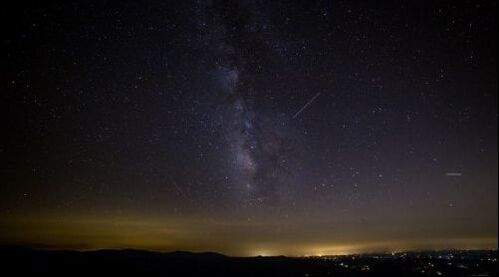|
Those looking to the stars this April can catch sight of a mesmerizing meteor shower in Florida, as well as across the US — and history says this one has been observed for nearly 3,000 years. Between April 15 and April 29 of 2023, the Lyrids Meteor Shower will dazzle viewers with its flashing fireballs. The best sights of the Lyrids happen during the shower's peak, which will occur between April 21 and 23 in the late evening and early morning hours. According to an interactive sky map for Clearwater, Florida from Time and Date, viewing conditions are expected to be good to very good on April 22 between the hours of approximately 10:30 and 10:55 pm. Visibility is expected to remain excellent as the night gets darker and inches toward peak hours, before beginning to phase out around 6 am to sunrise. Weather conditions will also impact visibility, with the current monthly forecast for according to AccuWeather showing little to no cloud coverage for Tampa Bay — the less clouds, the better your view. And while visible in Florida, the Lyrids will also be visible in other areas across the United States, with the Northern Hemisphere getting the best possible displays between moonset and dawn. Those hoping to catch the space show will want to look to the meteor shower's radiant, the point in the sky from which the shooting stars will appear — at approximately 58° to the East, Northeast, target your sights between the Hercules and Harp constellations and you'll be golden; the latter constellation is also called Lyra, which is how the Lyrids gets its name. The National Aeronautics and Space Administration (NASA) says for optimal viewing, it's best to look slightly away from the radiant. When you look directly at it, you'll find that the meteors will appear to be shorter in length, an effect of perspective known as foreshortening. This creates a flashing, almost "fireball"-like effect, rather than the long trail most may associate with shooting stars. Viewers will be able to catch approximately 10 to 20 meteors per hour traveling at a velocity of approximately 29 miles (or 27 kilometers) per second during the shower's peak on average, with Clearwater is currently estimated to see approximately 18 meteors per hour this year. However, the Lyrids has been known to occasionally surprise viewers with as many as 100 shooting stars per hour. These heavier showers occurred in 1803 in Virginia, 1922 in Greece, 1945 in Japan, and 1982 across the U.S, NASA states. And this astronomical event has been observed by humans for a really long time. According to NASA, the first recorded sighting of a Lyrid shower goes back 2,709 years to 687 BC, where it was first noted by the Chinese in historical texts. Where do these meteor showers even come from? Comets! Big, old space rocks interacting with our atmosphere. Every year, Earth passes through these trails of debris left behind by comets, which allows the bits to collide with planet's atmosphere. As they disintegrate, they create the fiery and colorful streaks we see in the inky darkness that is the sky. The fireballs in this dazzling display are created from debris originating from C/1861 G1, more commonly known as Comet Thatcher — though Thatcher wasn't discovered until much later on April 5, 1861 by A.E. Thatcher. Thatcher is categorized as a long period comet, meaning it's not expected to return to the inner solar system in any less than 200 years, as it takes about 415 years for this comet to orbit around the sun. Time and Date state that the comet is expected to be visible from Earth again in the year 2276. Planning to set up your blanket and watch this star show in April? Make sure to find an area well away from city or street lights. For the best experience, lay flat on your back or kick back in a lawn chair with your feet facing east and look up, taking in as much sky as possible. About 30 minutes after it gets dark, your eyes will adjust and you'll be able to start seeing meteors. Just remember to be patient if you don't see them right away — the show will last until dawn, so you'll have plenty of time to catch a glimpse. For more information about the Lyrids Meteor Shower, check out NASA's official page for the sky-high show here. Article by Rachael Volpe
0 Comments
Your comment will be posted after it is approved.
Leave a Reply. |
CATEGORIES |
|
|
Vertical Divider
|
Can't get enough?Uncover more of Florida through our channels below!
|
© COPYRIGHT 2015. ALL RIGHTS RESERVED.


 RSS Feed
RSS Feed